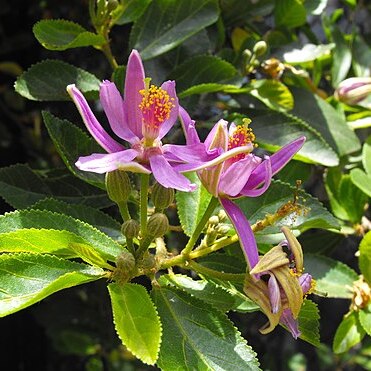A small tree. It can have many stems and be a rambling shrub. It can also climb. It grows up to 4 m tall. The trunk can be 30 cm across. It can have large spines. The older stems are square. The young twigs are hairy. The leaves are sword shaped and bright green. They have fine teeth along the edge. They are 2-5 cm long and 0.8-2.5 cm wide. They taper to a point. The base is often wedge shaped and lopsided. The flowers are oblong and have stalks. They are yellow and like stars. They are produced in the axils of leaves. The fruit are round and fleshy. They are 1 cm across. They can be yellow to red. They are edible.
Leaf-lamina 2–5 × 1–2·5 cm., oblong-ovate to lanceolate, acute to acuminate at the apex, broadly cuneate to rounded at the base, finely serrate or serrulate, glabrous or very sparsely appressed-stellate-pubescent on both sides; petiole 2–3 mm. long, sparsely setose-pubescent; stipules c. 6 mm. long, setaceous, very sparsely setulose-pubescent or glabrous.
Scandent shrub, up to 2 m high. Leaves glabrous or very sparsely stellate-pubescent on both sides. Androgyno-phore produced well beyond basal glabrous portion in a densely pubescent extension. Flowers yellow.
Petals yellow, slightly shorter than the sepals, with a basal nectariferous gland circumvillous within, produced into a ledge above and setose-pubescent on the back.
Inflorescences all axillary, on slender setulose-pubescent peduncles up to 7 mm. long; pedicels similar, 2–3 together, up to 1 cm. long.
Scandent many-stemmed shrub; branchlets sparsely setose-pubescent, soon becoming glabrous; older stems quadrangular.
Androgynophore glabrous below for 1 nun., produced above into a closely pubescent extension c. 2 mm. long.
Ovary ovoid, not lobed, setose-pubescent; style c. 7 mm. long, glabrous; stigma with 4 subulate lobes.
Fruit 7·5–10 mm. in diam., globose, never lobed, very sparsely stellate-pubescent or glabrous.
Sepals 6–9 mm. long, linear, finely pubescent on the back, glabrous within.
Flower-buds oblong.

